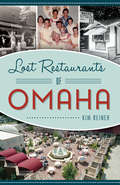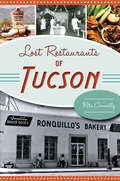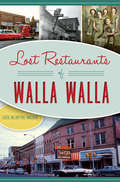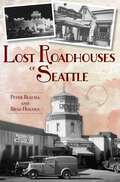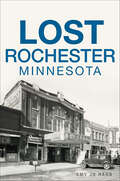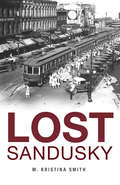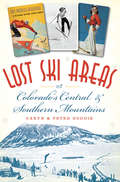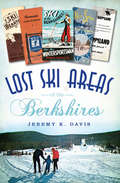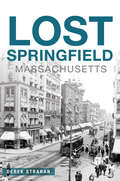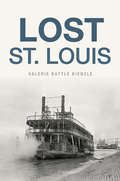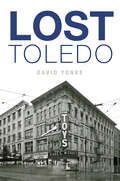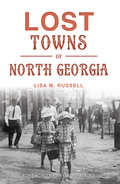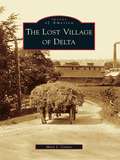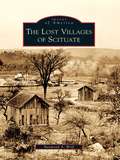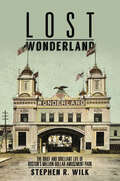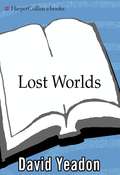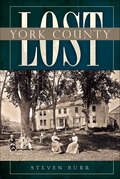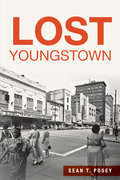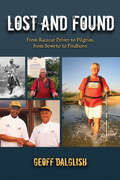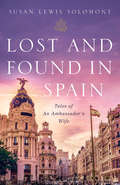- Table View
- List View
Lost Restaurants of Omaha (American Palate)
by Kim ReinerOmaha is known for its beef, but the history of its most famous restaurants goes far beyond. The French Café was the place to go to celebrate. Piccolo Pete's, Mister C's and Bohemian Café helped shape neighborhoods in Little Italy, North Omaha and Little Bohemia. The tales of restaurateurs like the tragic Tolf Hanson; the ever-optimistic Ross Lorello; Anthony Oddo, once a resident at Boys Town; and Giuseppa Marcuzzo, a former bootlegger, also tell the story of the city. Restaurants played a prominent role as history unfolded in Omaha during prohibition, wartime rations, the fight for equal rights and westward expansion. Author Kim Reiner details the fascinating history behind Omaha's classic eateries.
Lost Restaurants of Tucson (American Palate)
by Rita ConnellyFrom western roadhouses to fine dining, Tucson boasts an extraordinary lineup of diverse restaurants. Though some of its greatest no longer exist, their stories conjure the sights, smells and sounds of the city's history. Longtime locals still buzz about Gordo's famous chimichangas, an accidental dish originating in Tucson. The legendary Tack Room was a beacon of fine dining. Places like Café Terra Cotta and Fuego pioneered a new southwestern cuisine, serving regional dishes like prickly pear pork and stuffed poblanos. University of Arizona alumni miss old spots like the Varsity, while long-gone haunts like Gus & Andy's attracted a unique crowd of businessmen, movie stars and the occasional mobster. Join local food writer Rita Connelly as she serves up savory stories of good food and good company from the gone but never forgotten favorites of the Old Pueblo.
Lost Restaurants of Walla Walla (American Palate)
by Catie McIntyre WalkerDining in Walla Walla blossomed from an influx of mining transplants in the late 1800s. Within decades, a roadhouse called the Oasis boasted a seventy-two-ounce slab of beef, and the old Pastime Café opened at 5:30 a.m. with white toast and whiskey for breakfast. In the early 1950s, Ysidro Berrones opened one of the valley's first Mexican restaurants, the El Sombrero Tortilla Factory and Café. Owner of Denney's Hi-Spot for two decades, Joe Denney also satisfied locals with his morning crooning to piano on KTEL. Native and local wine writer Catie McIntyre Walker celebrates this rich heritage with decades of departed, beloved establishments and the people behind them.
Lost Roadhouses of Seattle (American Palate)
by Brad Holden Peter BlechaProhibition came early to Washington State--in 1916--and kicked off an unforgettable era of nightlife.Prohibition went national in 1920 and a network of roadside inns, taverns and dancehalls just outside of Seattle's city limits thrived well into the rockin' 1950s, providing illicit entertainment for those seeking a good time. Spurred on by early car culture and strict liquor laws, places like the Spanish Castle, The Jungle and The Black Cat sprang into being. Commonly called roadhouses, many of these remote outposts existed along two newly-built and parallel stretches of county highways - far from the prying eyes of city police. Fabled speakeasy operator, "Doc" Hamilton founded some of the earliest of these hideaways.Join authors Peter Blecha and Brad Holden as they uncover the fascinating era of forbidden nightclubs.
Lost Rochester, Minnesota (Lost)
by Amy Jo HahnRochester is synonymous with one of its most famous landmarks, the Mayo Clinic, but there's so much more to the Med City. It began as a frontier town, struggling to make its mark in a sparsely populated wilderness. By the late nineteenth century, Rochester had expanded into a vibrant city, rich with business, educational and cultural opportunities. Rediscover the Dubuque Trail and the beautiful summer lake retreats, along with the Cook Hotel, the Central Fire Station and more. Author Amy Jo Hahn uncovers the lost beginnings of Rochester and brings the stories of this unique place to life.
Lost Sandusky (Lost)
by M. Kristina SmithSANDUSKY BUILT ITS REPUTATION on the appeal of a picturesque lakefront and the opportunities of a manufacturing hub. Not only did its factories keep pace with the transportation industry, but the Ohio city also boasted the headquarters of international paper maker Hinde and Dauch and enough crayon production to be called the "Color Capital of the World." The amusement park at Cedar Point helped launch a new form of entertainment that continues today. But while the town remains a vacation destination and retains some heavy industry, it misses much of its former glory. Join M. Kristina Smith in revisiting those landmarks of Sandusky's past.
Lost Ski Areas of Colorado's Central and Southern Mountains
by Peter Boddie Caryn BoddieColorado's central and southern mountains still draw droves of skiers to the slopes. However, many of the historic runs and areas that were popular over the past century--some near the current resorts of Aspen, Breckenridge, Crested Butte, Purgatory, Telluride and Vail--no longer exist. Local hills like Whittaker Ranch near Eagle featured little more than a rope tow and warming hut. Now underneath Lake Dillon, Prestrud Jump hosted tournaments where Olympian Anders Haugen broke ski-jumping world records. From Lands End near Grand Junction to Sugarite near Trinidad, from swanky Hoosier Pass in Summit County to Stoner in Montezuma County, authors Caryn and Peter Boddie take readers on a tour of the lost ski areas of central and southern Colorado.
Lost Ski Areas of Tahoe and Donner
by Ingrid P. WickenAt the beginning of the twentieth century, Lake Tahoe and the Donner Summit region became California's first developed winter sports areas. Plentiful snowfall and newly built highways opened up the summer playground for visitors year-round, and skiing flourished. The Sierra Ski Club formed in 1925, attracting members eager to experience everything the mountains had to offer. People flocked to the slopes, visiting places like Clair Tappaan Lodge in Soda Springs, boasting one of the summit's earliest ski tows, and the Yuba Gap Lodge, a pioneer in night skiing. Join Ingrid P. Wicken, award-winning author and ski historian, as she recounts the fascinating beginnings of this celebrated ski hub.
Lost Ski Areas of the Berkshires (Lost)
by Jeremy K. DavisThe Berkshires of Massachusetts have long been known as a winter sports paradise. Forty-four ski areas arose from the 1930s to the 1970s. The Thunderbolt Ski Trail put the Berkshires on the map for challenging terrain. Major ski resorts like Brodie Mountain sparked the popularity of night skiing with lighted trails. All-inclusive resorts--like Oak n' Spruce, Eastover and Jug End--brought thousands of new skiers into the sport between the 1940s and 1970s. Over the years, many of these ski areas faded away and are nearly forgotten. Jeremy Davis of the New England/Northeast Lost Ski Areas Project brings these lost locations back to life, chronicling their rich histories and contributions to the ski industry.
Lost Springfield, Massachusetts (Lost)
by Derek StrahanAt the end of the nineteenth century, the U.S. Armory opened in Springfield, spurring rapid growth. With that golden age of progress came iconic buildings and landmarks that are now lost to time. Railroads brought workers eager to fill Springfield’s factories and enterprises like Smith & Wesson, Merriam Webster and Indian Motorcycles. The Massasoit House Hotel, the Church of the Unity and the Daniel B. Wesson mansion once served as symbols of the city’s grandeur. Forest Park grew into an upscale residential neighborhood of Victorian mansions. Join local historian Derek Strahan as he returns Springfield to its former glory, examining the people, events and—most importantly—places that helped shape the City of Firsts.
Lost St. Louis (Lost)
by Valerie Battle KienzleSt. Louis has been a shining beacon on the shores of the Mississippi River for more than 250 years, and many iconic landmarks have come and gone. The city hosted the World's Fair in 1904, with beautiful acres of buildings, gardens and fountains, nearly all of which are lost to time. Famous Busch Stadium now sits on an area that was once a vibrant community for Chinese immigrants. St. Louis Jockey Club was an expansive and popular gathering spot in the late nineteenth century until the state outlawed gambling. The Lion Gas Building was home to a unique mural featuring more than seventy shades of gray in tribute to famed aviator Charles Lindbergh. Author Valerie Battle Kienzle details the fantastic forgotten landmarks of St. Louis.
Lost Toledo (Lost)
by David YonkeLook back at some of the beloved places and landmarks in Toledo's past, from stores and stadiums to neighborhoods and nightclubs. Recall the birth of the Jeep, as well as unique shopping experiences at Tiedtke's, Lasalle's, Lamson's and Portside Festival Marketplace. Catch the action of a Toledo Mud Hens game at bygone ballpark Swayne Field. Watch the glittering marquees light up the downtown skyline once again with the names of performers ranging from Count Basie and Elvis Presley to B.B. King and KISS. Author David Yonke jogs fond memories in this nostalgic stroll through Toledo's heritage.
Lost Towns of Eastern Michigan (Lost)
by Alan NaldrettMany of eastern Michigan's old boomtowns and sleepy villages are faded memories. Nature reclaimed the ruins of some while progress paved over the rest. Discover the stories of lost communities hidden in plain sight or just off the beaten track. The vanished religious colony of Ora Labora fell into a state of near-constant inebriation when beer became the only safe liquid to drink. Lake St. Clair swallowed up the unique currency of Belividere along with the place that issued it. Abandoned towns still crumble within Detroit's city limits. Alan Naldrett delves into the fascinating history of eastern Michigan's lost settlements.
Lost Towns of North Georgia (Hidden History)
by Raymond Atkins Lisa M. RussellWhen the bustle of a city slows, towns dissolve into abandoned buildings or return to woods and crumble into the North Georgia clay. The remains of numerous towns dot the landscape--pockets of life that were lost to fire or drowned by the water of civic works projects. In 1832, Auraria was one of the sites of the original American gold rush. Cassville was a booming educational and cultural epicenter until 1864. Allatoona found its identity as a railroad town. Author and professor Lisa M. Russell unearths the forgotten towns of North Georgia.
Lost Trails, Lost Cities
by Colonel P. H. FawcettA chronicle of adventure and discovery in the green, deadly world of the jungle.This extraordinary first-hand account of seven explorations into the heart of the lost world of the Amazon Basin and its mountain ramparts has been made available for publication after more than a quarter of a century's silence. On his eighth and final expedition, Colonel P. H. Fawcett vanished into the jungle wilderness; to this day his fate is unknown. Before he began his last trip he set down the story of the expeditions he had completed, and his son, Brian Fawcett, here presents it together with a summary of the attempts to solve the mystery of his father's disappearance. Colonel Fawcett was an explorer in the great tradition. He believed that somewhere in the unmapped heart of South America were the ruins of cities whose discovery would confirm many Indian legends that had come down from the days of the conquistadores. Trained in the exacting techniques of exploration-survey, he accepted an opportunity to determine the boundary line between Bolivia and Peru, and in 1906 set out on the first of his expeditions. It and the ones that followed over the next fifteen years have become classics of exploration; Colonel Fawcett combined the discipline of a scientist-engineer with the imaginative daring of a man not afraid to gamble his life on a bold conjecture.In 1921 he set down the narrative of his first seven trips. When he failed to return from the eighth, publication was delayed until it became certain that he would never be able to complete his manuscript. But the reader will find here a wholly engrossing story of a great search written with modesty and great skill, the work of a brave and mature man who possessed both a purpose and a dream. The result is a book which will remain a classic in its field.
Lost Village of Delta, The (Images of America)
by Mary J. CentroHome to a community of hardworking farmers and mill workers, the village of Delta stood along the banks of the Mohawk River until it was evacuated by the state to raise the water in the Erie Canal. Before the flooding of the river, Delta was a small country village with the same postmaster for over 30 years and families farming the same land for generations. In order to raise the water, the state approved the construction of five reservoirs across New York. The town was evacuated soon after, and the land that generations of residents toiled over now sits at the bottom of Lake Delta.
Lost Villages of Scituate, The (Images of America)
by Raymond A. WolfIn 1915, the general assembly appointed the Providence Water Supply Board to condemn 14,800 acres of land in rural Scituate. The hardworking people of the five villages were devastated. By December 1916, notices were delivered to the villagers stating that the homes and land they had owned for generations were to be taken and destroyed. Construction was well under way by 1921, and water was being stored by November 10, 1925. On September 30, 1926, the treatment plant began operation. It now serves more than 60 percent of Rhode Islanders. The $21 million project was the largest ever undertaken in the state at the time. The dam that annihilated the villages is 3,200 feet long and 100 feet high and holds back more than 40 billion gallons of water. Today these quiet villages lie up to 87 feet beneath the cold, dark waters of the Scituate Reservoir.
Lost Wonderland: The Brief and Brilliant Life of Boston's Million Dollar Amusement Park
by Stephen R. WilkIf you take Boston's Blue Line to its northern end, you'll reach the Wonderland stop. Few realize that a twenty-three-acre amusement park once sat nearby—the largest in New England, and grander than any of the Coney Island parks that inspired it. Opened in Revere on Memorial Day in 1906 to great fanfare, Wonderland offered hundreds of thousands of visitors recreation by the sea, just a short distance from downtown Boston. The story of the park's creation and wild, but brief, success is full of larger-than-life characters who hoped to thrill attendees and rake in profits. Stephen R. Wilk describes the planning and history of the park, which featured early roller coasters, a scenic railway, a central lagoon in which a Shoot-the-Chutes boat plunged, an aerial swing, a funhouse, and more. Performances ran throughout the day, including a daring Fires and Flames show; a Wild West show; a children's theater; and numerous circus acts. While nothing remains of what was once called "Boston's Regal Home of Pleasure" and the park would close in 1910, this book resurrects Wonderland by transporting readers through its magical gates.
Lost Worlds
by David YeadonThe author of The Back of Beyond continues the chronicle of his odyssey into some of the farthest corners of the world, from the Mountains of the Moon in Zaire, to wilderness Tasmania, to the unknown regions of New Guinea.
Lost York County (Lost)
by Steven BurrOn October 17, 1947, a fire started near Newfield. It grew quickly and moved east, destroying Goose Rocks Beach, Fortune�s Rock and parts of Cape Porpoise. Thousands of historic buildings perished. The 1947 blaze was unique in the scope of its devastation, but fire has claimed countless York County landmarks over the years. Development projects, neglect and weather have doomed many more. Lost York County presents rare photos of many of these buildings, preserving the visual record of lost town halls, churches, schools, homes and hotels, from Kittery to Biddeford. In this collection of many never-before-seen images, Steven Burr offers a tribute to places and memories seized by time.
Lost Youngstown (Lost)
by Sean T. PoseyThe massive steel mills of Youngstown once fueled the economic boom of the Mahoning Valley. Movie patrons took in the latest flick at the ornate Paramount Theater, and mob bosses dressed to the nines for supper at the Colonial House. In 1977, the Youngstown Sheet and Tube Company announced the closure of its steelworks in a nearby city. The fallout of the ensuing mill shutdowns erased many of the city's beloved landmarks and neighborhoods. Students hurrying across a crowded campus tread on the foundations of the Elms Ballroom, where Duke Ellington once brought down the house. On the lower eastside, only broken buildings and the long-silent stacks of Republic Rubber remain. Urban explorer and historian Sean T. Posey navigates a disappearing cityscape to reveal a lost era of Youngstown.
Lost and Found
by Geoff DalglishTackling the goal to walk 25,000 miles -the equivalent of the circumference of the planet - one man shares life-changing insights through his personal travel vignettes. Formerly a thrill-seeking journalist, Geoff Dalglish begins his impressive expedition after undergoing a spiritual and ecological awakening at the Findhorn center in Scotland. His deliberate journey from Timbuktu to Antarctica to Hollywood unfolds in vivid and inspiring detail, revealing a wealth of unimaginable experiences while sharing a message about treading lightly on the Earth. From the horrors of bloody civil unrest and death-defying moments at the hands of armed guerilla soldiers to close encounters with the animal kingdom and finding healing balm within spiritual communities, this roller coaster of adventure chronicles a deeper quest for meaning that culminates in the joys of a life lived in simplicity and service.
Lost and Found In Spain: Tales of An Ambassador's Wife
by Susan Lewis SolomontWhen her husband was appointed by President Barack Obama to be U.S. Ambassador to Spain and Andorra, Susan Solomont uprooted herself. She left her career, her friends and family, and a life she loved to join her husband for a three-and-a-half-year tour overseas. Part memoir and part travelogue, Solomont learns the rules of a diplomatic household; goes on a culinary adventure with some of Spain's greatest chefs; finds her place in the Madrid Jewish community; and discovers her own voice to create new meaning in her role as a spouse, a community member, and a 21st century woman.
Lost and Found in Venice: The warm and cosy Christmas read of 2024!
by Joanna KnowlesRosie Redbrush, a travel agent working for Wanderlust Wishes travel agency, is someone who sells holidays but never takes them. At twenty-nine, she lives a quiet, comfortable life in the town she grew up in. But then, just a few days before Christmas, a problematic customer tricks Rosie into becoming a tour guide for a group of ten disgruntled old-age pensioners in Venice! And suddenly, Rosie's quiet life is thrown into disarray. Escorting an elderly group through the streets of Italy's most romantic city is hard enough, but throw in a neurotic aquaphobe, an accidental Santa race, a regrettable selfie, and a missing backpack, suddenly Rosie finds herself extremely lost in Venice, without a penny or a passport to her name.Rosie can't go home. And as she travels Italy looking for a solution, what she doesn't expect to find are a loving family, a group of eclectic new friends, and the possibility of true love in the most unlikely of places...The gorgeous new festive romcom from Joanna Knowles, Lost and Found in Venice is guaranteed to be your favourite new comfort read.
Lost and Found in Venice: The warm and cosy Christmas read of 2024!
by Joanna KnowlesRosie Redbrush, a travel agent working for Wanderlust Wishes travel agency, is someone who sells holidays but never takes them. At twenty-nine, she lives a quiet, comfortable life in the town she grew up in. But then, just a few days before Christmas, a problematic customer tricks Rosie into becoming a tour guide for a group of ten disgruntled old-age pensioners in Venice! And suddenly, Rosie's quiet life is thrown into disarray. Escorting an elderly group through the streets of Italy's most romantic city is hard enough, but throw in a neurotic aquaphobe, an accidental Santa race, a regrettable selfie, and a missing backpack, suddenly Rosie finds herself extremely lost in Venice, without a penny or a passport to her name.Rosie can't go home. And as she travels Italy looking for a solution, what she doesn't expect to find are a loving family, a group of eclectic new friends, and the possibility of true love in the most unlikely of places...The gorgeous new festive romcom from Joanna Knowles, Lost and Found in Venice is guaranteed to be your favourite new comfort read.
